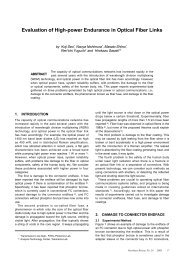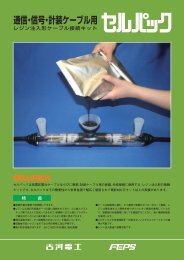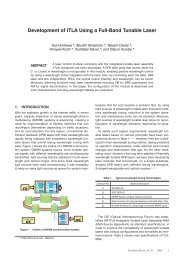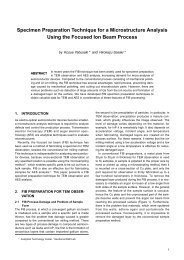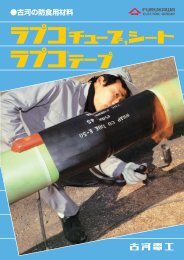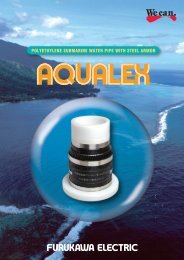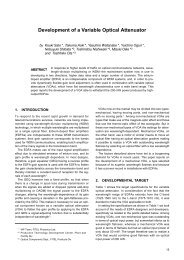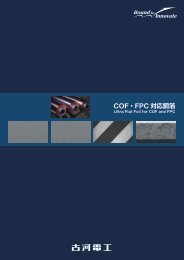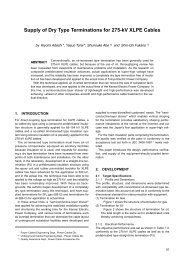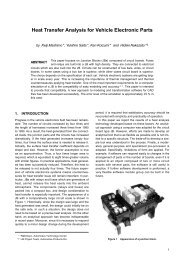Underground Power Cable, Distribution Cable, Overhead
Underground Power Cable, Distribution Cable, Overhead
Underground Power Cable, Distribution Cable, Overhead
You also want an ePaper? Increase the reach of your titles
YUMPU automatically turns print PDFs into web optimized ePapers that Google loves.
<strong>Underground</strong> <strong>Power</strong> <strong>Cable</strong>, <strong>Distribution</strong> <strong>Cable</strong>, <strong>Overhead</strong> Transmission Line, Industrial <strong>Cable</strong> and Their Accessories<br />
demand for isolated island connection cables over long<br />
distances will grow in future.<br />
2. JOINT FOR HIGH-VOLTAGE XLPE<br />
CABLES<br />
Because XLPE cable is characterized by its ease of maintenance,<br />
the cable rapidly proliferated domestically in the<br />
1960s when its application began, currently constituting<br />
the majority of domestic power cables having voltage ratings<br />
of 66-kV and higher. During this period, we have<br />
developed the sealing end and the extrusion molded joint<br />
for XLPE cable joints, achieving significant improvements<br />
in terms of performance, ease of installation, reduction of<br />
joint size and so forth.<br />
As the cable rating was upgraded from the 66-kV class<br />
to the 154-kV, 275-kV and further to the 500-kV class, we<br />
carried out development concentrating on the reliability<br />
and work management of joints, thereby achieving an<br />
extremely low rate of dielectric breakdown across the<br />
world. Moreover, since the late 1990s when 500-kV XLPE<br />
cables have been put into actual use, studies have been<br />
made focusing on simplifying the installation process for<br />
joints as well as reducing their sizes, and new joints that<br />
utilize new structures and materials have been developed<br />
for practical application.<br />
A rubber block-based intermediate joint named cold<br />
shrinkable joint (CSJ) is one of these developments,<br />
which is aimed at simplifying the installation process. The<br />
structure of CSJ is such that a rubber block insulator (see<br />
Figure 10) that is molded at the factory in advance is used<br />
as a reinforcing insulator to fit to the cable joint. The CSJ<br />
has achieved, due to its simple structure, a significant<br />
reduction in installation time and simplification of work<br />
management when compared with taped joints where an<br />
insulating tape is wound at the work site, or with field<br />
molded joints where cross-linked polyethylene is used to<br />
integrally mold the cable at high pressure and high temperature.<br />
Currently the CSJ is practically applied to the<br />
154-kV class domestically as well as to the 220-kV class<br />
overseas, and the one for 400 kV has already been devel-<br />
Figure 10 Rubber block insulator for 220-kV rating.<br />
oped, so that its application area is growing. Moreover,<br />
aiming at simplification of installation work, we are presently<br />
developing a simplified termination which applies<br />
rubber block insulator and oil to a termination, whereby<br />
the 110-kV class has already been put into practical<br />
application, while the 220-kV class is under development.<br />
As for termination using new materials, on the other<br />
hand, a composite-type termination has been developed,<br />
which is based on composite insulator that consists of<br />
FRP insulator and silicone rubber sheds instead of porcelain<br />
insulator. Because the composite insulator is lighter<br />
than porcelain insulator, it is considerably advantageous<br />
in that the assembly work can be carried out safely in a<br />
shorter period of time without using heavy machinery.<br />
With respect to electrical characteristics, it has been confirmed<br />
that the composite insulator is comparable to or<br />
better than porcelain insulator due to the water-shedding<br />
property of silicone rubber. While the composite insulator<br />
has been applied to the 154-kV class presently, it is<br />
expected that the application will grow to higher-voltage<br />
regions in the future.<br />
In addition, an insulation oil-free, 77-kV class dry composite<br />
type termination (see Figure 11) has been developed,<br />
which utilizes silicone rubber for the outer jacket<br />
molded on an epoxy insulator. The termination is advantageous<br />
in that free-angle installation is allowed for; no oil<br />
leak occurs making it environment friendly; and jointing<br />
work of cable takes only a short time because compact<br />
versions of the CSJ mentioned above are used.<br />
Introduction of dry composite type terminations to higher<br />
voltage ratings has just begun, so that the application is<br />
expected to expand in the future.<br />
Furthermore, we have two kinds of compact joints,<br />
namely: compact transition joint for different types of<br />
cables such as the XLPE and OF cables; and compact Ybranch<br />
joint (see Figure 12) for three XLPE or OF cables.<br />
These achievements have been realized by accumulating<br />
design technologies, whereby the structural dimensions<br />
Figure 11 Dry composite type termination for 77-kV rating.<br />
Furukawa Review, No. 32 2007





